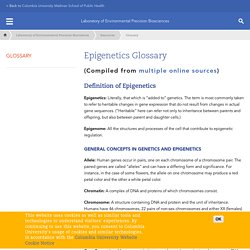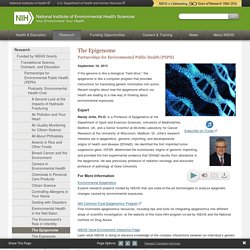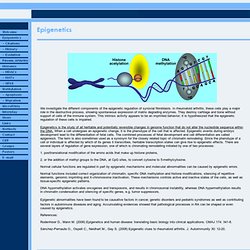

Epigenetics Glossary. (Compiled from multiple online sources) Epigenetics: Literally, that which is “added to” genetics.

The term is most commonly taken to refer to heritable changes in gene expression that do not result from changes in actual gene sequences. (“Heritable” here can refer not only to inheritance between parents and offspring, but also between parent and daughter cells.) Epigenome: All the structures and processes of the cell that contribute to epigenetic regulation. General concepts in genetics and epigenetics Allele: Human genes occur in pairs, one on each chromosome of a chromosome pair. Chromatin: A complex of DNA and proteins of which chromosomes consist. Chromosome: A structure containing DNA and protein and the unit of inheritance. Gamete: A reproductive germ cell — an egg cell in the female or sperm in the male. Gene Expression: Most commonly this term refers to the production of messenger RNA (mRNA) using a DNA gene sequence as a template.
DNA Methylation Histone Modifications. Epigenetics. Epigenetic Inheritance: Concepts, Mechanisms and Perspectives. Epigenetics: What Makes Us Who We Are? - Begin Before Birth. Epigenetics Explained [Animation] The Epigenome. September 16, 2013 If the genome is like a biological "hard drive," the epigenome is like a computer program that provides instructions for translating genetic information into action.

Recent insights about how the epigenome affects our health are leading to a new way of thinking about environmental exposures. Expert Randy Jirtle, Ph.D. is a Professor of Epigenetics at the Department of Sport and Exercise Sciences, University of Bedfordshire, Bedford, UK, and a Senior Scientist at McArdle Laboratory for Cancer Research at the University of Wisconsin, Madison. Dr. For More Information Environmental Epigenetics Explore research projects funded by NIEHS that use state-of-the-art technologies to analyze epigenetic changes caused by environmental exposures. NIEHS Gene-Environment Interaction Page Learn what NIEHS is doing to advance knowledge of the complex interactions between an individual’s genetic make-up and environmental agents.
NOVA: Epigenetics Watch Dr. We want your feedback! Back to Top. Epigenetics. We investigate the different components of the epigenetic regulation of synovial fibroblasts.

In rheumatoid arthritis, these cells play a major role in the destructive process, showing spontaneous expression of matrix degrading enzymes. They destroy cartilage and bone without support of cells of the immune system. This intrinsic activity appears to be an imprinted behavior; it is hypothesized that the epigenetic regulation of these cells is impaired. Epigenetics is the study of all heritable and potentially reversible changes in genome function that do not alter the nucleotide sequence within the DNA. When a cell undergoes an epigenetic change, it is the phenotype of the cell that is affected. 1. posttranslational modification of the amino acids that make up histone proteins, 2. or the addition of methyl groups to the DNA, at CpG sites, to convert cytosine to 5-methylcytosine. References: Epigenomics. The Ghost In Your Genes. Nutrition and the Epigenome. DNA isn’t everything. Research into epigenetics has shown that environmental factors affect characteristics of organisms.
These changes are sometimes passed on to the offspring. ETH professor Renato Paro does not believe that this opposes Darwin’s theory of evolution. A certain laboratory strain of the fruit fly Drosophila melanogaster has white eyes. If the surrounding temperature of the embryos, which are normally nurtured at 25 degrees Celsius, is briefly raised to 37 degrees Celsius, the flies later hatch with red eyes.
If these flies are again crossed, the following generations are partly red-eyed – without further temperature treatment – even though only white-eyed flies are expected according to the rules of genetics. Environment affects inheritance Researchers in a group led by Renato Paro, professor for Biosystems at the Department of Biosystems Science and Engineering (D-BSSE), crossed the flies for six generations. The concept of epigenetics offers an explanation for this result.
Cells have a memory. Educational Resources.
Molecular visuals.